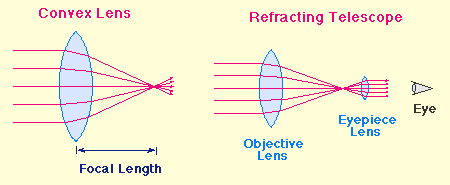Optical telescopes may be divided into two general categories: (1)
refracting telescopes that use lenses to gather and focus light, and
(2) reflecting telescopes that use mirrors to accomplish the same
purpose. We discuss the principles of refracting telescopes in this section
and of reflecting telescopes in the following section.
Principle of Refraction
As we have discussed in earlier sections, the direction of light propagation is
changed at the boundary of glass and air by
refraction.
By designing lenses having the right
curvature, this principle can be used to gather and focus light. The following
figure illustrates the use of a lens to gather and focus light, and the use of
two lenses to make a simple refracting telescope.
 |
|
Principle of refraction and the refracting telescope
|
Chromatic Aberration
One problem with refracting telescopes is that there is a frequency dependence
for refraction, so the amount of refraction at each surface of the lens depends
on the wavelength. Thus, different wavelengths focus at slightly different
points. This is called chromatic aberration, and causes objects like
stars to be surrounded by fuzzy, rainbow colored halos. Chromatic aberration
can be corrected by using a second carefully designed lens mounted behind the
main objective lens of the telescope to compensate for the chromatic aberration
and cause two wavelengths to focus at the same point. This is called
an ACHROMATIC lens, but with a second such lens one only gets
two wavelengths to focus at the same point, e.g. red and yellow. Then
the blue wavelengths would be off.

